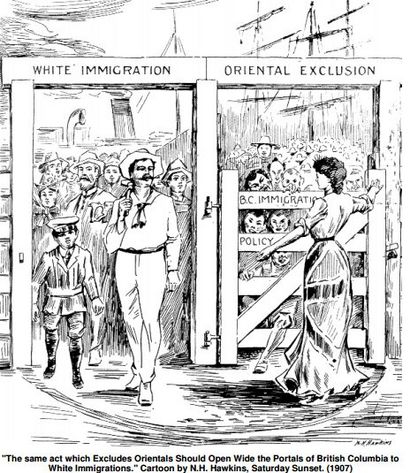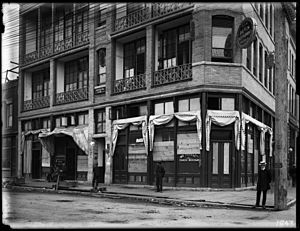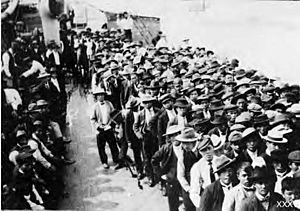Anti-Oriental riots (Vancouver) facts for kids
Quick facts for kids Vancouver anti-Asian riots |
|||
|---|---|---|---|
| Part of the Pacific Coast race riots of 1907 | |||

Exclusionist cartoon in Saturday Sunset magazine by N.H. Hawkins, Vancouver, 24 August 1907
|
|||
| Date | September 7–9, 1907 | ||
| Location | |||
| Caused by | anti-immigration sentiment | ||
| Parties to the civil conflict | |||
|
|||
| Casualties | |||
| Death(s) | none confirmed | ||
| Injuries | unknown | ||
| Arrested | At least 19 | ||
| Fined | ~$36,420 indemnities | ||
The Vancouver riots occurred September 7–9, 1907, in Vancouver, British Columbia, Canada. At about the same time there were similar anti-Asian riots in San Francisco, Bellingham, Washington, and other West Coast cities. They were not coordinated, but instead reflected common underlying anti-immigration attitudes. Agitation for direct action was led by labour unions and small business. No one was killed but the damage to Asian-owned property was extensive. One result was an informal agreement whereby the government of China stopped emigration to Canada.
Causes of riots
In the early years of the twentieth century race relations on the Pacific Coast of Canada were strained. There were an estimated 16,000 Chinese immigrants in the province at the 1901 census, an increase from the prior 1881 (4,350) and 1891 (8,910) counts. There were also 8,000 Japanese and around 5,000 South Asians. The Chinese had come to Canada to build the railways; the Japanese to fish; and Indians to farm and log.
At this time, other ships with more migrants were arriving, including the Suian Maru [83 Japanese, 1906], SS Kumeric [1,177 Japanese, 1907], SS Tartar [514 Indians, 1907], and the SS Monteagle [901 Indians, further 100 in 1908]. Meanwhile, the Panic of 1907, caused by the failure of Augustus Heinze's brother's bank in New York, exacerbated the difficult labour market and brought racial tensions to the fore.
White people perceived Asians as taking "their" jobs. Australia had enacted the Immigration Restriction Act 1901 which promulgated the White Australia policy and eliminated Asian immigration shortly after confederation. The Asian Exclusion League in Canada lobbied for Canada to do the same.
The riots that broke out on September 7 of 1907 were the accumulation of growing enmity toward the Asian immigrants that were coming to the United States and parts of Canada. "By the end of October 1907, new arrivals totaled 11,440. Of these immigrants the Japanese accounted for 8,125, the Chinese 1,266, and the Punjabi Sikhs 2,049". As the numbers of Asian immigrants continued to grow, anti-Asian activist began to feel threatened that the Japanese could "ultimately control [Vancouver] part of Canada". The riots represented the voices and feelings of anti-Asian activists, in attempt to "convince federal authorities of the seriousness of anti-Japanese sentiment in British Columbia".
Events
The 1907 Vancouver riot was the second act of anti-Asian violence in the history of Vancouver; the first incident took place in the area of Coal Harbour, in 1887. A riot targeting East Indian lumber workers in Bellingham in 1907 started the events. Shortly thereafter, tensions flared in the north and angry mobs stormed through Powell Street in Vancouver's Chinatown, breaking windows and assaulting Chinese people in the streets. The riot lasted three days in September 1907; finally the Vancouver police closed the streets and calm slowly returned. Many windows were broken and the population was terrified. The second day of the riot turned against the Japanese community. There were similar actions in Steveston in Richmond against the Japanese.
Immediate lead-up
Early in 1907 the Grand Trunk and Pacific Railway lobbied Ottawa to let it import 10,000 Japanese workers to build its line in Northern BC [this figure is often misquoted as 50,000]. Premier Bowser did not like such large numbers and opposed such a large Asian influx. On August 12, 1907, members of the Asiatic Exclusion League met and developed a resolution. The document asked the Canadian government to "enforce the Immigration Act passed by the provincial legislature in the Spring of 1907", but the Canadian Government refused to endorse the proposed act.
At about the same time there were similar anti-Asian riots in San Francisco, Bellingham, Washington, and other West Coast cities. They were not coordinated, but instead reflected common underlying anti-Asian nativism. The Vancouver riots were a direct result of the race riot in Bellingham, Washington, on September 5, 1907. Many Chinese victims of the Bellingham race riots fled for Canada, subsequently fuelling the Asiatic Exclusion League of Vancouver to take a stance against anti-Asian immigration.
Parade and riot
At the third meeting, members of the Asiatic Exclusion League decided to plan a parade for Saturday the 7th of September, which would include a band in order to draw attention. The parade would lead to Vancouver City Hall at Hastings and Main (then named Westminster), next to Chinatown, where a rally would be held to address the issues of Asian Immigration. 10,000 Canadian and American citizens marched in that anti-Asian immigration parade, which resulted in a mob rioting throughout Chinese and Japanese neighbourhoods within Vancouver, British Columbia, Canada.

As various speakers were discussing the Bellingham riot, the sound of shattering glass caused by a rock tossed by an unruly teen, had sounded the beginning of what would become a much larger riot in Vancouver. The crowd gathered at the parade turned into a rioting mob, throwing beer bottles and rocks at windows, attempting to destroy Chinese owned stores and homes. Most of the buildings attacked during the Vancouver riots were Caucasian owned.
The mob of rioters moved to Japantown after destroying Chinese business and homes. Four waves of attacks ensued, with the rioters being repulsed by the armed Japanese residents. In spite of inflicting a number of injuries upon the mob, more than 50 stores and businesses in the Japanese district on Powell Street had their windows broken, resulting in thousands of dollars of damage. The Vancouver riot was not finished until 3 o'clock in the morning on September 8, by the time dawn had broken the city was quiet.
Aftermath
Labour Minister MacKenzie King was detailed to write a Royal Commission into the events. He also recompensed the damage with $36,000 to the Japanese-Canadian community.
The Vancouver race riot resulted in bans on immigration for Japanese people. This ban was titled the gentlemen's agreement and was enacted in Canada on January 25, 1908. Within this treaty Japan agreed to "restrict the number of passports issued to make labourers and domestic servants to an annual maximum of 400". In addition to the Gentlemen's agreement, Canada also passed the "Continuous journey" legislation, which allowed Japanese immigrant to "finish" their journey to the United States.
The Vancouver pogrom was talked about at length by the German Emperor Wilhelm II in his interview with the British Colonel Edward Montagu-Stuart-Wortley that set off the Daily Telegraph Affair of 1908. In the interview, Wilhelm warned of the Yellow Peril that was said to be threatening Western civilization, and used the Vancouver pogrom as an example of what he called the "corruption" of British foreign policy, which he predicated would soon flounder between the contradictions of anti-Asian feelings in Canada vs. Britain's alliance with Japan. Wilhelm argued that Britain had to "protect" Canada from Asian immigration, which he would mean conflict with Japan, leading him to predicate disaster for the British empire.
Although spared the worst of the riots by remaining indoors, the aftermath nevertheless affected Indians living in the province. In 1908 the British Columbia government passed a law preventing South Asian men from voting. Because eligibility for federal elections originated from provincial voting lists, they were also unable to vote in federal elections. The Canadian government also enacted a $200 head tax on Indian immigration and required immigrants to take a continuous journey from their country of origin to Canada; there were no boats which sailed directly from India to Canada. After 1908, yearly South Asian immigration to Canada did not exceed 80 until the 1940s. A direct result of these restrictions set the stage for one of the most infamous events in Vancouver history, the Komagata Maru Incident in 1914.


